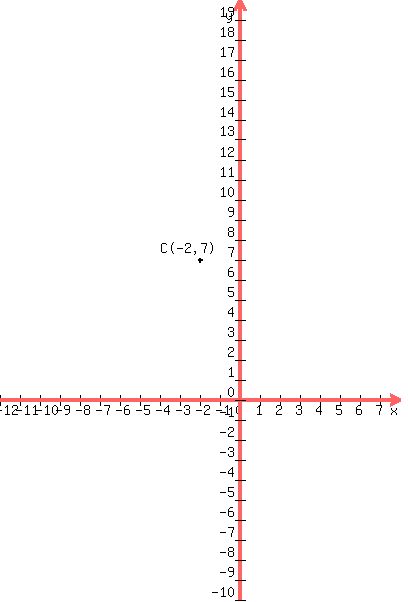Instead of doing yours for you, I'll do one
exactly like it, which you can use as a model:


 ,
,  ,
,
 , so
, so 
 , so
, so  The center (h,k) = (-2,7)
We start out plotting the center C(h,k) = C(-2,7)
The center (h,k) = (-2,7)
We start out plotting the center C(h,k) = C(-2,7)
 Next we draw the left semi-transverse axis,
which is a segment a=5 units long horizontally
left from the center. This semi-transverse
axis ends up at one of the two vertices (-7,7).
We'll call it V1(-7,7):
Next we draw the left semi-transverse axis,
which is a segment a=5 units long horizontally
left from the center. This semi-transverse
axis ends up at one of the two vertices (-7,7).
We'll call it V1(-7,7):
 Next we draw the right semi-transverse axis,
which is a segment a=5 units long horizontally
right from the center. This other semi-transverse
axis ends up at the other vertex (3,7).
We'll call it V2(3,7):
Next we draw the right semi-transverse axis,
which is a segment a=5 units long horizontally
right from the center. This other semi-transverse
axis ends up at the other vertex (3,7).
We'll call it V2(3,7):
 That's the whole transverse ("trans"="across",
"verse"="vertices", the line going across from
one vertex to the other. It is 2a in length,
so the length of the transverse axis is 2a=2(5)=10
Next we draw the upper semi-conjugate axis,
which is a segment b=8 units long verically
upward from the center. This semi-conjugate
axis ends up at (-2,15).
That's the whole transverse ("trans"="across",
"verse"="vertices", the line going across from
one vertex to the other. It is 2a in length,
so the length of the transverse axis is 2a=2(5)=10
Next we draw the upper semi-conjugate axis,
which is a segment b=8 units long verically
upward from the center. This semi-conjugate
axis ends up at (-2,15).
 Next we draw the lower semi-conjugate axis,
which is a segment b=8 units long verically
downward from the center. This semi-conjugate
axis ends up at (-2,-1).
Next we draw the lower semi-conjugate axis,
which is a segment b=8 units long verically
downward from the center. This semi-conjugate
axis ends up at (-2,-1).
 That's the complete conjugate axis. It is 2b in length,
so the length of the transverse axis is 2b=2(8)=16
Next we draw the defining rectangle which has the
ends of the transverse and conjugate axes as midpoints
of its sides:
That's the complete conjugate axis. It is 2b in length,
so the length of the transverse axis is 2b=2(8)=16
Next we draw the defining rectangle which has the
ends of the transverse and conjugate axes as midpoints
of its sides:
 Next we draw and extend the two diagonals of this defining
rectangle:
Next we draw and extend the two diagonals of this defining
rectangle:
 Now we can sketch in the hyperbola:
Now we can sketch in the hyperbola:
 The foci are points inside the hyperbola, which are the distance c
from the center, where c is calculated by
The foci are points inside the hyperbola, which are the distance c
from the center, where c is calculated by
 (just like the Pythagorean theorem, from whence
it comes):
(just like the Pythagorean theorem, from whence
it comes):




 So the two foci are
So the two foci are  units
right and left of the center, which is
(h,k) = (-2,7)
Therefore the foci are:
(
units
right and left of the center, which is
(h,k) = (-2,7)
Therefore the foci are:
( ,7) and (
,7) and ( ,7)
They are approximately the points:
(-11.4,7) and (7.4,7). I won't bother plotting
them.
All that's left to do is find the equations of the two asymptotes.
Their slopes are ±
,7)
They are approximately the points:
(-11.4,7) and (7.4,7). I won't bother plotting
them.
All that's left to do is find the equations of the two asymptotes.
Their slopes are ± or ±
or ± The asymptote that has slope
The asymptote that has slope  goes through the center
C(-2,7), so its equation is found using the point-slope
formula:
goes through the center
C(-2,7), so its equation is found using the point-slope
formula:


 Multiply through by 5
Multiply through by 5


 The asymptote that has slope
The asymptote that has slope  goes through the center
C(-2,7), so its equation is found using the point-slope
formula:
goes through the center
C(-2,7), so its equation is found using the point-slope
formula:


 Multiply through by 5
Multiply through by 5


 -----------------------------------------------
Edwin
-----------------------------------------------
Edwin